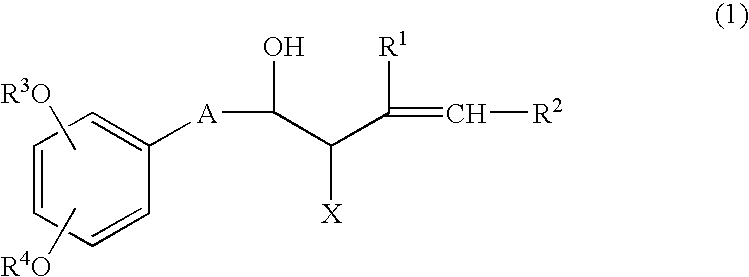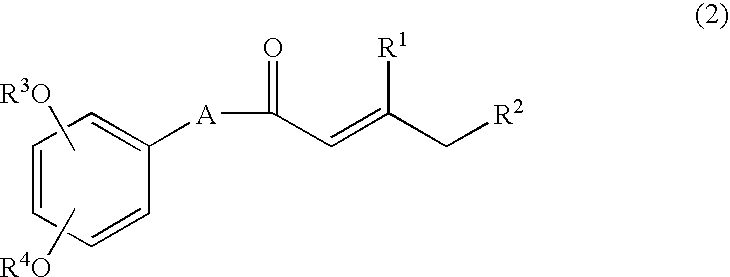Process for producing shogaols and intermediates for the synthesis thereof
a technology of shogaol and intermediates, which is applied in the direction of drug compositions, bulk chemical production, antinoxious agents, etc., can solve the problems of low yield of gingerols, laborious separation and purification of gingerols from naturally occurring materials, and only trace amounts of shogaols, etc., to inhibit tyrosinase activity and inhibit melanin synthesis.
- Summary
- Abstract
- Description
- Claims
- Application Information
AI Technical Summary
Benefits of technology
Problems solved by technology
Method used
Image
Examples
example 1
[0037] The intermediate compound M1 (of the following formula (7)) of the invention was synthetically prepared by reacting the compound of the following formula (5) with the compound of the following formula (6).
Compound of the Formula (5);
Compound of the Formula (6);
Compound M1;
[0038] 1.81 g (7.17 mmol) of the compound of the formula (5) was dissolved in 30 ml of tetrahydrofuran, and the resulting solution was cooled to −78° C. with dry ice / acetone. To the resulting solution was dropwise added 4.50 ml (7.16 mmol) of 1.59 M n-butyllithium / n-hexane solution. After the resulting mixture was agitated at the same temperature for 20 minutes, a solution of 1.71 g (6.71 mmol) of the compound 2 dissolved in 20 ml of tetrahydrofuran was dropwise added to the mixture. After dropwise addition, the resulting mixture was agitated at the same temperature for 10 minutes. Then, the temperature was gradually elevated. When the temperature of the reaction solution reached −20° C., 2 ml of m...
example 2
[0044] Using the compound of the formula (5) and the compound of the formula (8), the intermediate compound M2 (of the following formula (9)) was synthetically prepared.
Compound of the Formula (8);
Compound M2;
[0045] 3.46 g (13.7 mmol) of the compound of the formula (5) was dissolved in 50 ml of tetrahydrofuran, and the resulting solution was cooled to −78° C. with dry ice / acetone. To the resulting solution was dropwise added 9.10 ml (13.7 mmol) of 1.50 M n-butyllithium / n-hexane solution. After the resulting mixture was agitated at the same temperature for 20 minutes, a solution of 3.49 g (13.0 mmol) of the compound (8) dissolved in 50 ml of tetrahydrofuran was dropwise added to the mixture. After dropwise addition, the resulting mixture was agitated at the same temperature for 10 minutes. Then, the temperature was gradually elevated. When the temperature of the reaction solution reached −10° C., 2 ml of methanol was added to terminate the reaction. After 30 ml of saturated aq...
example 3
[0050] Using the compound of the formula (10) and the compound of the formula (8), the intermediate compound M3 (of the following formula (11)) was synthetically prepared.
Compound of the Formula (10);
Compound M3;
[0051] 3.65 g (13.7 mmol) of the compound of the formula (10) was dissolved in 50 ml of tetrahydrofuran, and the resulting solution was cooled to −78° C. with dry ice / acetone. To the resulting solution was dropwise added 9.10 ml (13.7 mmol) of 1.50 M n-butyllithium / n-hexane solution. After the resulting mixture was agitated at the same temperature for 20 minutes, a solution of 3.49 g (13.0 mmol) of the compound (8) dissolved in 50 ml of tetrahydrofuran was dropwise added to the mixture. After dropwise addition, the resulting mixture was agitated at the same temperature for 10 minutes. Then, the temperature was gradually elevated. When the temperature of the reaction solution reached −10° C., 2 ml of methanol was added to terminate the reaction. After 30 ml of saturate...
PUM
 Login to View More
Login to View More Abstract
Description
Claims
Application Information
 Login to View More
Login to View More - R&D Engineer
- R&D Manager
- IP Professional
- Industry Leading Data Capabilities
- Powerful AI technology
- Patent DNA Extraction
Browse by: Latest US Patents, China's latest patents, Technical Efficacy Thesaurus, Application Domain, Technology Topic, Popular Technical Reports.
© 2024 PatSnap. All rights reserved.Legal|Privacy policy|Modern Slavery Act Transparency Statement|Sitemap|About US| Contact US: help@patsnap.com










